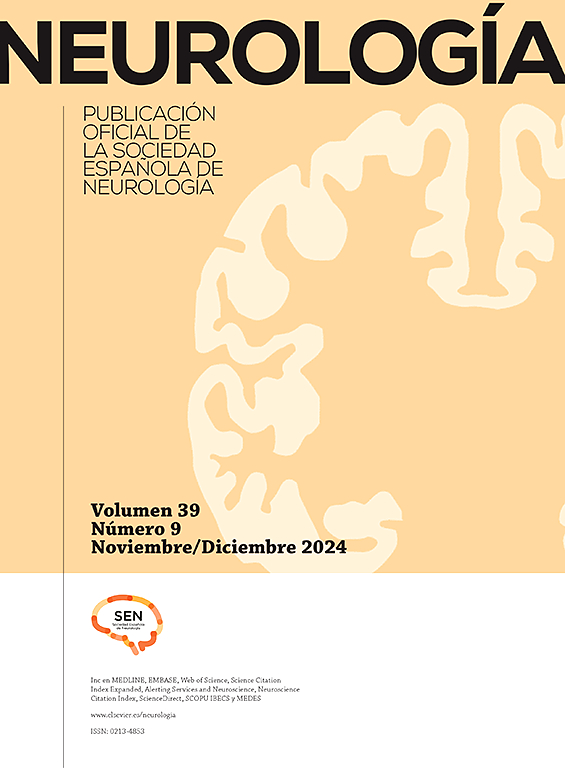β-石竹烯抑制MPTP诱导的帕金森病血脑屏障通透性
IF 3.1
4区 医学
Q2 CLINICAL NEUROLOGY
引用次数: 0
摘要
帕金森病(PD)是世界上第二常见的神经退行性疾病。尽管PD的确切发病机制尚不清楚,但一些研究表明,氧化应激、炎症、低水平抗氧化剂和产生活性氧的生物分子的存在可以破坏血脑屏障(BBB),这是该疾病的一个基本特征。目的在1-甲基-4-苯基-1,2,3,6-四氢吡啶(MPTP)帕金森诱导模型中,研究β-石竹烯(BCP)对大麻素受体2型(CB2)的激动作用是否能纠正血脑屏障的通透性。方法对MPTP小鼠模型进行蛋白(免疫化学和western blot)、血脑屏障通透性和PD(脂质过氧化)相关生物标志物的分子评估。结果mptp组小鼠纹状体和黑质致密部闭塞带(ZO-1)和闭塞蛋白紧密连接(TJ)蛋白的表达受到抑制,纹状体脂质过氧化和血脑屏障通透性增加,BCP组逆转上述作用。该植物大麻素能够恢复MPTP小鼠酪氨酸羟化酶(TH)、离子钙结合转接器分子1 (Iba-1)和胶质纤维酸性蛋白(GFAP)的蛋白表达和免疫反应性,以及核因子-红细胞2相关因子(NRF2)向细胞核的易位和NADPH醌氧化酶1 (NQO1)的表达。结论CB2作为PD的治疗靶点,其激活可能改善PD相关血脑屏障破坏和氧化应激,减少多巴胺能神经元的选择性死亡。本文章由计算机程序翻译,如有差异,请以英文原文为准。
Beta-caryophyllene inhibits the permeability of the blood–brain barrier in MPTP-induced parkinsonism
Introduction
Parkinson's disease (PD) is the second most prevalent neurodegenerative disorder worldwide. Although the precise pathogenesis of PD remains unclear, several studies demonstrate that oxidative stress, inflammation, low levels of antioxidants, and the presence of biomolecules that generate reactive oxygen species can disrupt the blood–brain barrier (BBB) as an essential feature of the disease.
Aims
This study aimed to test whether agonism to cannabinoid receptor type 2 (CB2) through the administration of β-caryophyllene (BCP) could correct BBB permeability in the 1-methyl-4-phenyl-1,2,3,6-tetrahydropyridine (MPTP) parkinsonism induction model.
Methods
We conducted a molecular assessment of proteins (immunochemistry and western blot), BBB permeability, and related biomarkers of PD (lipid peroxidation) in the MPTP mouse model of the disease.
Results
Expression of zonula occludens (ZO-1) and occludin tight junction (TJ) proteins was dampened in the striatum and substantia nigra pars compacta of mice, while lipid peroxidation and BBB permeability increased in the striatum in the MPTP-treated group, and these effects were reversed under BCP administration. This phytocannabinoid was able to restore protein expression and immunoreactivity of tyrosine hydroxylase (TH), ionized calcium-binding adapter molecule 1 (Iba-1), and glial fibrillary acidic protein (GFAP), as well as nuclear factor-erythroid 2-related factor (NRF2) translocation to the nucleus, and NADPH quinone oxidase 1 (NQO1) expression in mice treated with MPTP.
Conclusion
These results highlight the role of CB2 as a therapeutic target for PD, suggesting that its activation may ameliorate PD-related BBB disruption and oxidative stress, reducing the selective death of dopaminergic neurons.
求助全文
通过发布文献求助,成功后即可免费获取论文全文。
去求助
来源期刊

Neurologia
医学-临床神经学
CiteScore
5.90
自引率
2.60%
发文量
135
审稿时长
48 days
期刊介绍:
Neurología es la revista oficial de la Sociedad Española de Neurología y publica, desde 1986 contribuciones científicas en el campo de la neurología clínica y experimental. Los contenidos de Neurología abarcan desde la neuroepidemiología, la clínica neurológica, la gestión y asistencia neurológica y la terapéutica, a la investigación básica en neurociencias aplicada a la neurología. Las áreas temáticas de la revistas incluyen la neurologia infantil, la neuropsicología, la neurorehabilitación y la neurogeriatría. Los artículos publicados en Neurología siguen un proceso de revisión por doble ciego a fin de que los trabajos sean seleccionados atendiendo a su calidad, originalidad e interés y así estén sometidos a un proceso de mejora. El formato de artículos incluye Editoriales, Originales, Revisiones y Cartas al Editor, Neurología es el vehículo de información científica de reconocida calidad en profesionales interesados en la neurología que utilizan el español, como demuestra su inclusión en los más prestigiosos y selectivos índices bibliográficos del mundo.
 求助内容:
求助内容: 应助结果提醒方式:
应助结果提醒方式:


